Review sản phẩm
Đánh giá tai nghe Audeze Maxwell – Sự thăng hoa từ SoundGuys
Giới thiệu Audeze Maxwell review – SoundGuys
Đánh giá Audeze Maxwell – SoundGuys
Audeze Maxwell – một bài đánh giá sản phẩm tuyệt vời từ SoundGuys đã thu hút sự chú ý của cộng đồng yêu âm thanh. Với chất lượng âm thanh vượt trội và thiết kế tinh tế, tai nghe này thực sự xứng đáng để được mua ngay tại Queen Mobile.
#Review #AudezeMaxwell #SoundGuys #QueenMobile
Việc đánh giá sản phẩm là một yếu tố quan trọng giúp người dùng hiểu rõ hơn về tính năng và hiệu suất của sản phẩm trước khi quyết định mua. Với bài đánh giá sắc sảo từ SoundGuys, người dùng có thể tìm hiểu về những ưu điểm nổi bật của tai nghe Audeze Maxwell.
Tai nghe Audeze Maxwell mang đến chất lượng âm thanh rõ ràng, chi tiết và mượt mà. Người dùng có thể trải nghiệm âm nhạc với những chi tiết tinh tế và sự cân bằng hoàn hảo giữa các dải âm. Sự độc đáo của Audeze Maxwell nằm ở thiết kế Open-back, tạo ra âm thanh mở rộng với không gian rộng lớn và độ tách bạch tốt giữa các nhạc cụ và giọng ca.
Với thương hiệu uy tín và những đánh giá tích cực từ SoundGuys, Queen Mobile tự tin là nơi lý tưởng để mua ngay tai nghe Audeze Maxwell. Với sự tận tâm và chuyên nghiệp, Queen Mobile cam kết mang đến trải nghiệm mua sắm tốt nhất cho khách hàng.
Quý khách hàng có thể đến Queen Mobile để trải nghiệm trực tiếp tai nghe Audeze Maxwell và nhận được sự tư vấn chuyên sâu từ đội ngũ nhân viên giàu kinh nghiệm. Chúng tôi cam kết đem đến niềm vui và sự hài lòng cho quý khách hàng.
Hãy đến ngay Queen Mobile và trải nghiệm âm thanh tuyệt hảo cùng Audeze Maxwell. Chúng tôi luôn sẵn lòng phục vụ và đáng tin cậy trong việc mang lại trải nghiệm mua sắm tốt nhất cho bạn.
#QueenMobile #AudezeMaxwell #TaiNgheChấtLượng #TrảiNghiệmTuyệtHảo
QUEEN MOBILE chuyên cung cấp điện thoại Iphone, máy tính bảng Ipad, đồng hồ Smartwatch và các phụ kiện APPLE và các giải pháp điện tử và nhà thông minh. Queen Mobile rất hân hạnh được phục vụ quý khách….
_____________________________________________________
Mua #Điện_thoại #iphone #ipad #macbook #samsung #xiaomi #poco #oppo #snapdragon giá tốt, hãy ghé [𝑸𝑼𝑬𝑬𝑵 𝑴𝑶𝑩𝑰𝑳𝑬] ✿ 149 Hòa Bình, phường Hiệp Tân, quận Tân Phú, TP HCM
✿ 402B, Hai Bà Trưng, P Tân Định, Q 1, HCM
✿ 287 đường 3/2 P 10, Q 10, HCM
Hotline (miễn phí) 19003190
Thu cũ đổi mới
Rẻ hơn hoàn tiền
Góp 0%
Thời gian làm việc: 9h – 21h.
KẾT LUẬN
Audeze Maxwell là một thiết bị tai nghe được đánh giá cao về chất lượng âm thanh của SoundGuys. Tai nghe này mang đến trải nghiệm âm thanh tuyệt vời với hiệu suất cao và khả năng tái tạo âm thanh rõ ràng, chi tiết. Với thiết kế sang trọng và đẳng cấp, Audeze Maxwell thu hút người dùng bằng vẻ ngoài mạnh mẽ và chất lượng xây dựng chắc chắn. Ngoài ra, tai nghe cũng có khả năng cách âm tốt, mang lại trải nghiệm nghe nhạc tuyệt vời và êm ái. Đặc biệt, Audeze Maxwell còn sở hữu nút điều chỉnh âm lượng thông minh, giúp người dùng thay đổi âm lượng một cách dễ dàng mà không cần sử dụng điện thoại hay máy tính. Với những ưu điểm nổi bật này, Audeze Maxwell là lựa chọn lý tưởng cho những người mua muốn tìm kiếm tai nghe cao cấp và đáng đồng tiền bát gạo.
Aimed at the high end of the market, Audeze is no stranger to making audiophile-oriented headsets. The LCD-GX is rock-solid, but what if you want a wireless battle buddy? That’s where the Audeze Maxwell comes in.
Editor’s note: this is the first version of the article. Updates will follow as the market changes.
About this review: We tested the Audeze Maxwell over six days. It ran firmware version 1.0.1.46, and the Audeze HQ app ran version 3.1.57. The company provided the unit for this review.
The Audeze Maxwell is for gamers looking for a capable gaming and media-consumption headset that eliminates many gripes from the traditional design. As a counterpoint to Audeze’s LCD-GX, this gaming headset has multiplatform-friendly features and design.
What’s it like to use the Audeze Maxwell?
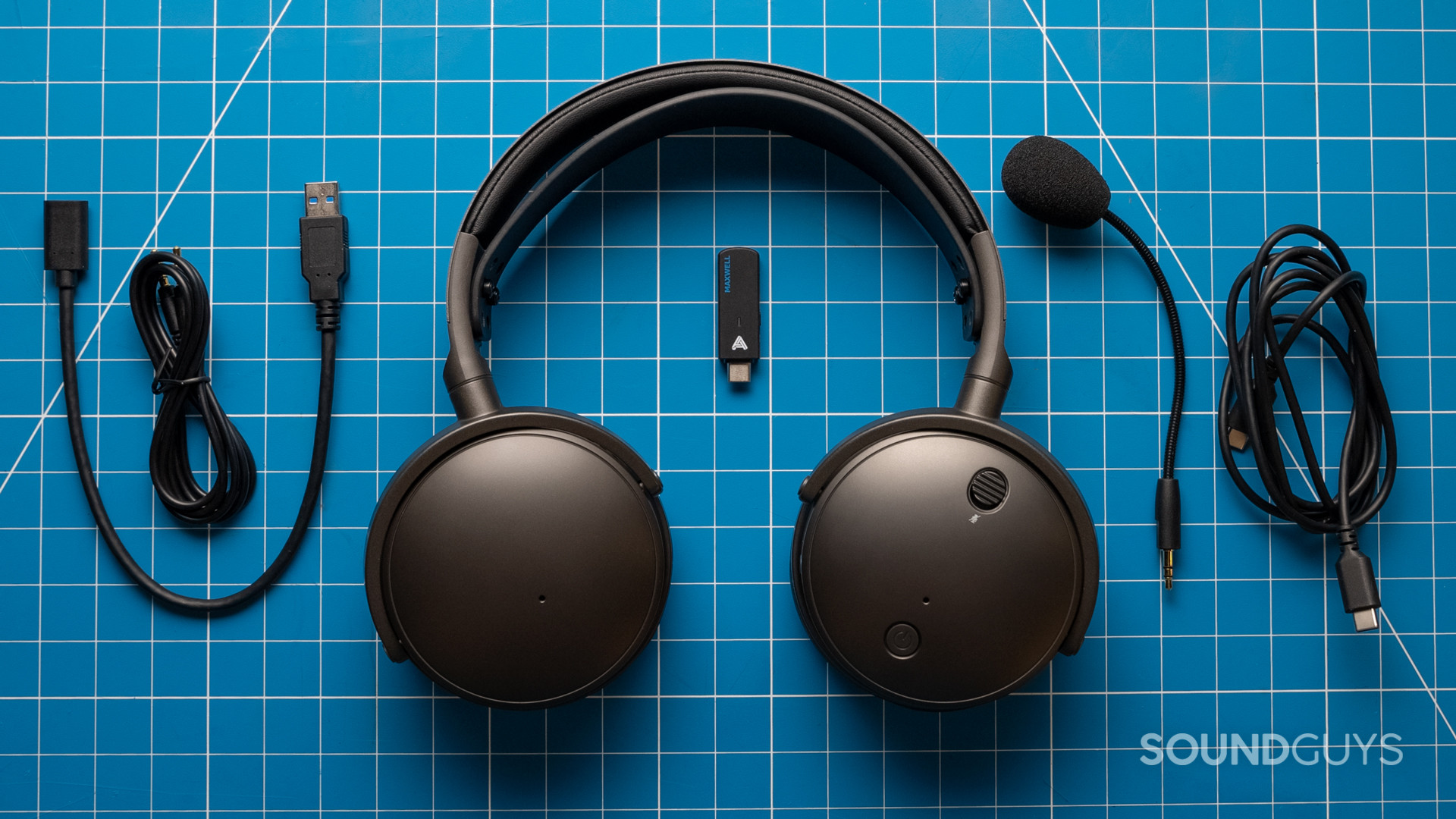
Christian Thomas / SoundGuys
You get a lot of headset with the Maxwell and many parts to keep track of.
When you open the box to the Audeze Maxwell, you’ll be greeted with a large amount of packing foam, documentation, a USB cable, a 3.5mm cable, a USB-A to USB-C converter, USB-C RF dongle, a boom mic, and of, course: your gaming headset. There’s a lot to unpack here, but for now, you can store the cables and dongles in a safe space near your gaming setup because you may not end up using some of these depending on what platforms you will be using.
If you’re going to be using your headset with a PlayStation or Xbox, it’s best to get the correct version, as hardware licensing and software doesn’t always play nice from version to version. Consequently, you might find your experience to be pretty miserable if you’re stuck using wired connections because you got the wrong version. We recommend the Xbox version if you’re primarily using these for PC.
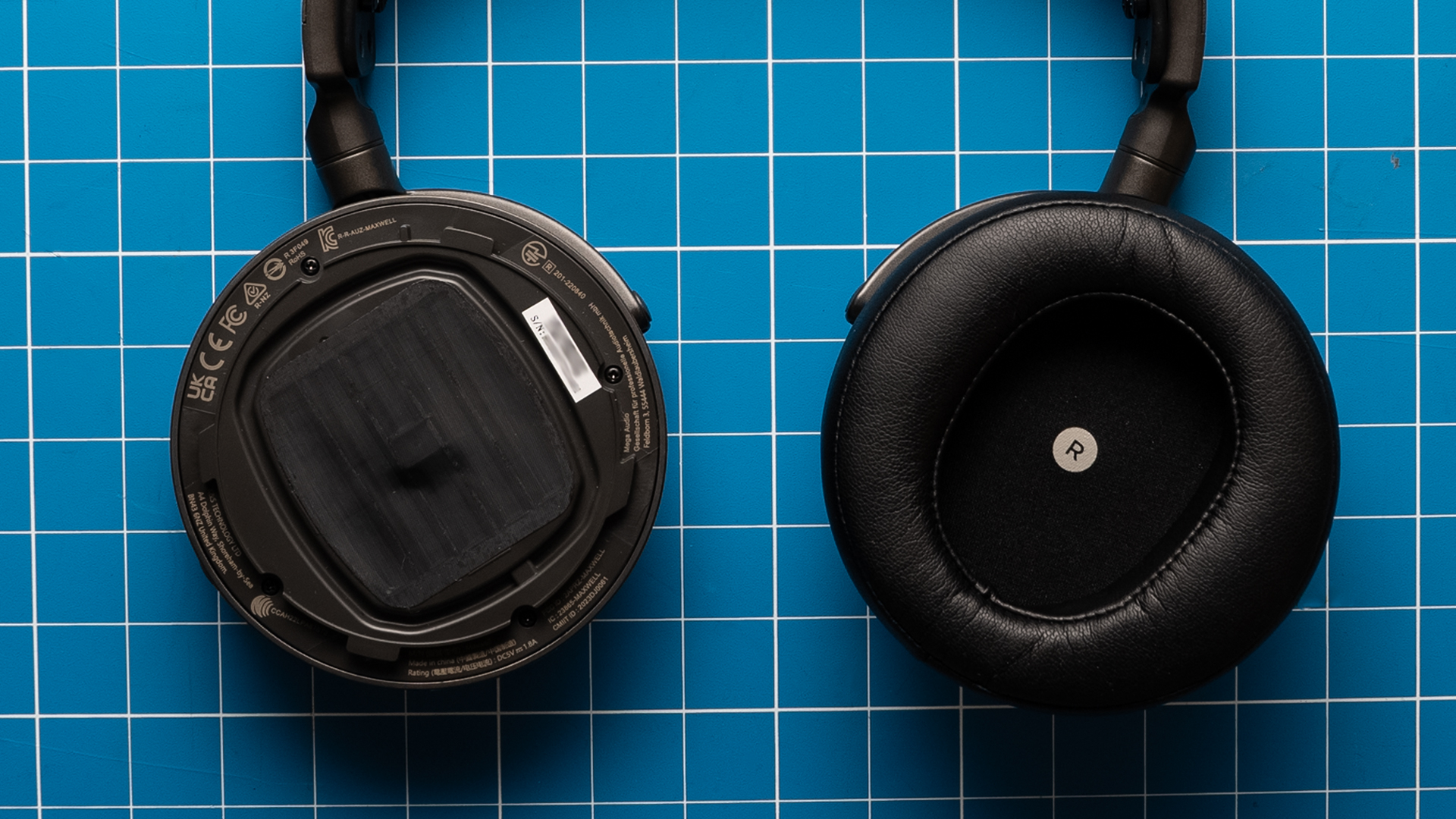
Christian Thomas / SoundGuys
Large planar drivers and deep ear cups give the Audeze Maxwell a good foot forward.
As a gaming headset, the Audeze Maxwell has almost everything you could want from such a product: it’s compatible with any device, high-end planar magnetic drivers, and a proprietary dongle that enables low-latency wireless connectivity and Bluetooth. Deep and soft ear pads mean that there will be few out there who will have issues with their outer ear getting compressed, and this makes your experience much more likely to be a good one, sound-wise.
However, the news isn’t all rosy. Though the internal guts and features of the Audeze Maxwell are all high-performers, the construction has a few foibles. The ear cups are a strong point of the headset — but that headband is a weak one. Instead of a padded band or suspended strap, the Audeze Maxwell uses a mishmash of both that varies in effectiveness from person to person. I’m all for simpler designs that aim to eliminate sources of frustration, but this needs a trip back to the drawing board because of long-term durability concerns.
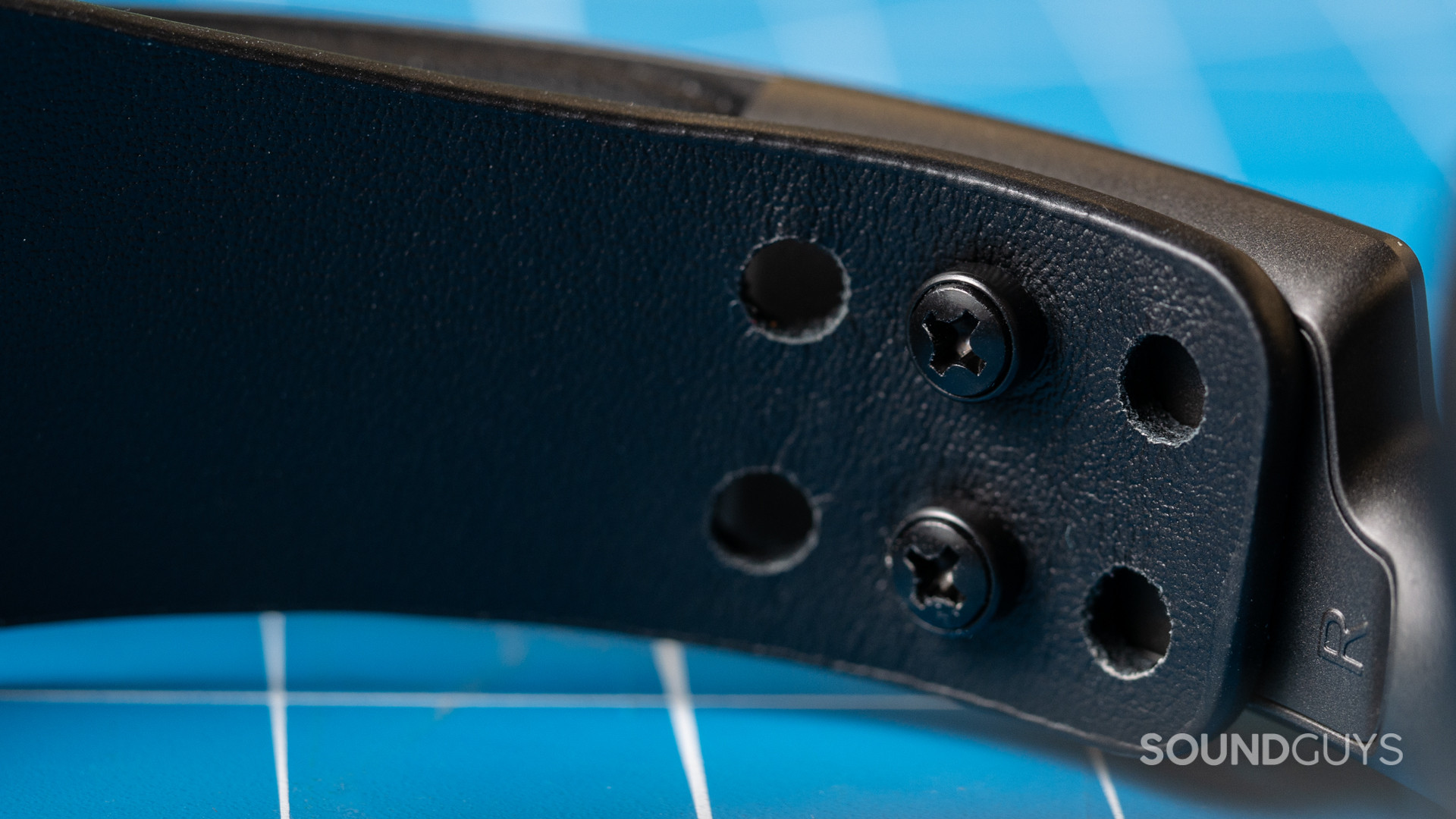
Christian Thomas / SoundGuys
Don’t remove the screws holding the strap anchors in place.
If you need to adjust said band, you do not have to unscrew those little anchor pegs, despite the impression that you’ll have to. Instead, you can torque the leather-like strap off each anchor (don’t be gentle), and then you can pop the strap back on using different pre-cut holes to adjust the band tightness. Unfortunately, this doesn’t suit every brain cage, nor is it built for the long term. Malleable leather-like materials fatigue as you put force on them over time so that you could stretch the holes a bit after extended use.
It’s not a pressing worry but a durability concern over the years. However, your options are limited if you need help getting a good fit. I understand why metal grommets weren’t used, but there needs to be something to relieve the strain on the cut holes in the band — or at least make the adjustment nubs redundant with a system more like the one found on Audeze’s other headphones with suspended bands. Maybe that will change on a newer version.
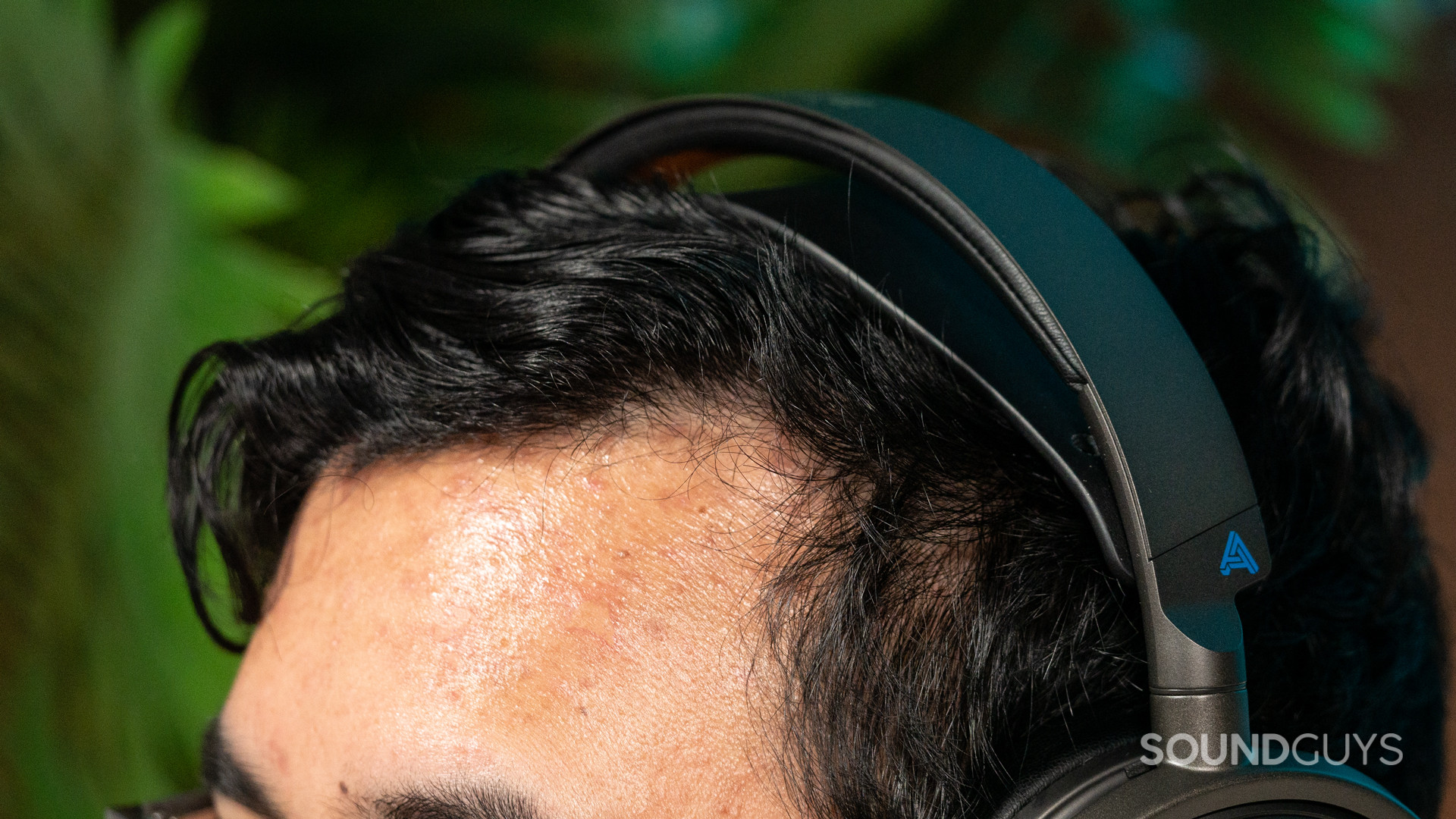
Christian Thomas / SoundGuys
The band of the Audeze Maxwell is a bit odd but capable enough.
Because the Maxwell has a hefty mass of 490g (1.07 lbs), weight distribution matters much more for this headset than others. Had the band been thicker or used a different suspension mechanism, comfort issues might have been less noticeable. But it’s tough to work around this much mass being supported by your neck. For example, while I could use these for several hours before they became uncomfortable, some colleagues had issues right out of the box. Like it is with any headset, fit can vary.
How do you control the Audeze Maxwell?
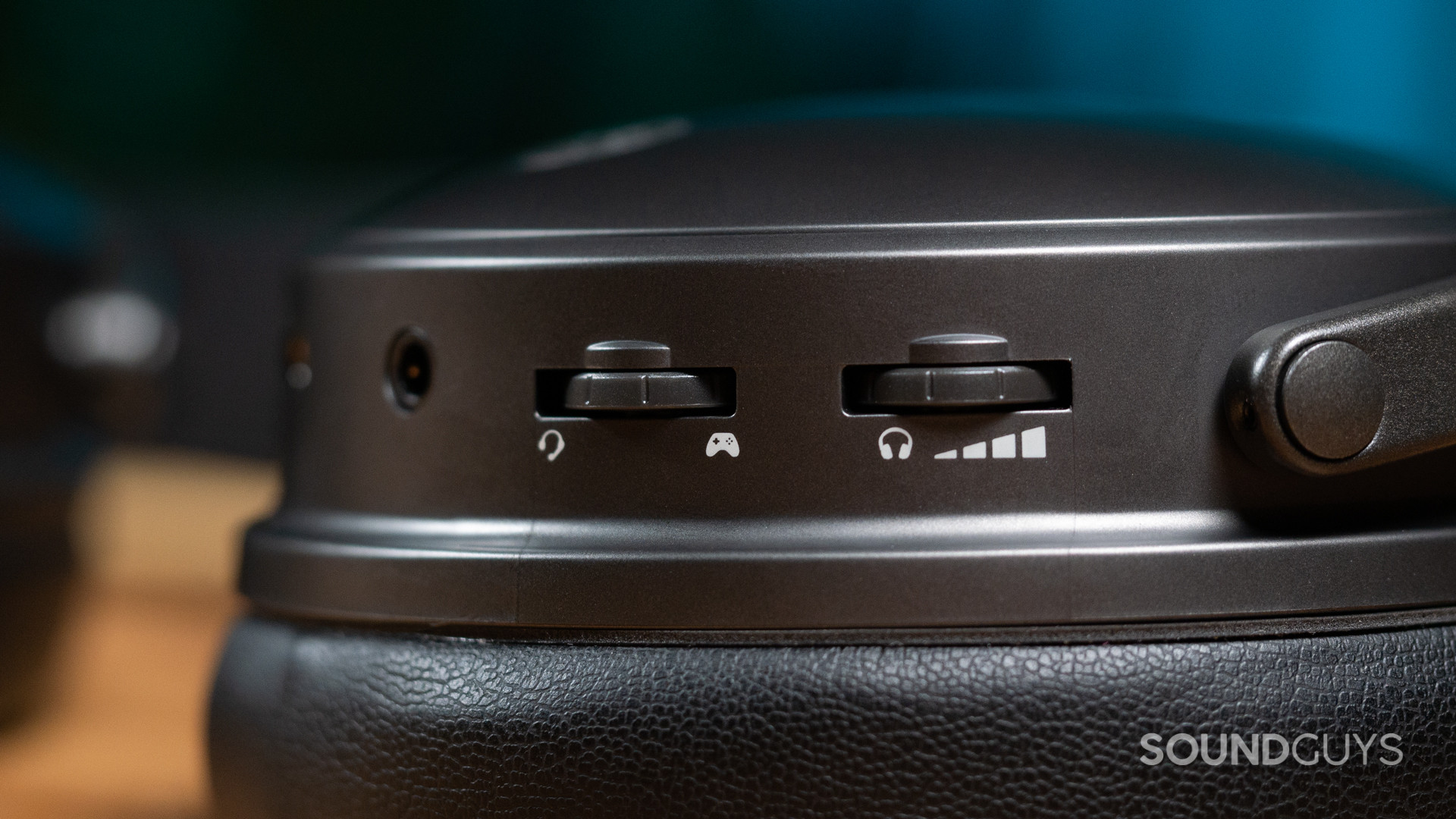
Christian Thomas / SoundGuys
Modifying the sidetone and master volume from your headset is always welcome.
As far as on-set controls go, the Audeze Maxwell’s primary modes of interaction are the physical buttons and wheels on the left ear cup. The ones here are clever and useful in ways that aren’t immediately obvious. For example, the game and media intermix wheel allows you to adjust the levels of your game and sidetone. This removes the annoyances of having your speech intermixed with your game audio while mid-deathmatch, where some headsets are pretty awful at setting an appropriate level. The Audeze Maxwell sidesteps this issue by allowing you to adjust it to your liking — or turn it off entirely.
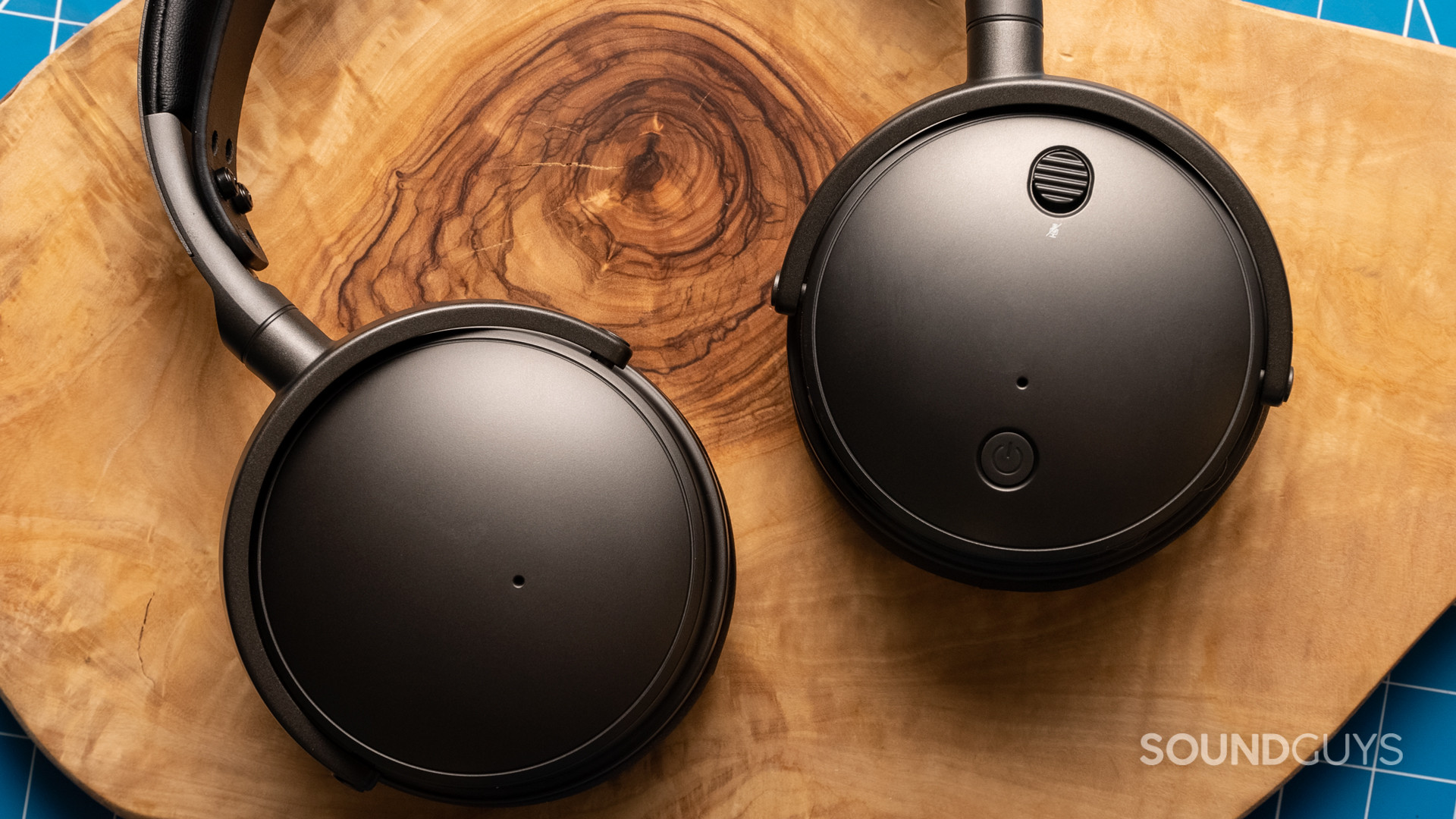
Christian Thomas / SoundGuys
A physical slider for the mic mute means no guessing if your mic is the problem on a call.
Additionally, the mic mute slider on the top of the ear cup provides a physical control that’s impossible to misread. It’s better to have the ability to mute your hardware quickly rather than guess if the whole Discord channel can hear you.
| Control | One press | Two presses | Long press | Scroll |
|---|---|---|---|---|
| Control
Power button |
One press
Play / pause music |
Two presses
Bluetooth pairing |
Long press
Power on / off |
Scroll
N/A |
| Control
Game/chat wheel |
One press
Adjust sidetone |
Two presses
Sidetone on / off |
Long press
N/A |
Scroll
Adjust game / chat mix |
| Control
Volume wheel |
One press
Next / previous track (scroll while pressed) |
Two presses
EQ Preset (scroll while pressed) |
Long press
N/A |
Scroll
Adjust headphone volume |
For the most part, the controls of the Audeze Maxwell are physical if the app doesn’t entirely handle them, and that’s not bad. Being able to adjust things without the assistance of software is always a plus.
What do the different LED colors mean?
If you look at the side of the left ear cup, you’ll see an LED indicator that tells you about your device’s status. Below is each status indication and its meaning.
| LED behavior | Meaning |
|---|---|
|
Solid white |
USB dongle paired |
|
Solid blue |
Bluetooth connected |
|
Blinking white / blue |
Bluetooth pairing |
|
Blue blinking |
Bluetooth not connected |
|
Solid green |
Battery full |
|
Solid red |
Low battery |
|
Blinking red |
Battery charging |
Should you use the Audeze HQ app for the Audeze Maxwell?
Gaming headset apps can be a colossal pain — we’ve had to reinstall operating systems over particularly crappy ones — but at least Audeze’s app seems stable on Windows 10 and 11. By installing the app, not only are you enabling things like firmware upgrades (you want that), but you’re also unlocking a lot of software features like spatial audio, EQ presets, and more.
But this goes a bit further, and it’s in a way that used to drive me bonkers in Team Fortress 2 back in the day. Clever-yet-foolish snipers and engineers used to use EQ apps like Voicemeeter to boost game audio in the 100Hz and 3kHz ranges (and also run a dynamic compressor to cut loud sounds) to hear footsteps around you much easier, and Audeze added something similar to that as an EQ preset in its app. While I loathe that this is so easy to do now, I respect the filthy things I could do mid-death match to people who thought they got the drop on me. Abuse this.
EQ presets should offer you some advantage or perform better than the default tuning. These do in this case, so use the Audeze HQ app.
How do you connect the Audeze Maxwell?
If you wanted a gaming headset that could connect to damn near everything, the Audeze Maxwell can. In addition to the 3.5mm TRS cable most wired headsets use, you can connect to your source via USB-C, the included RF dongle, or Bluetooth 5.3. Thankfully, support for USB-C audio and the latest Bluetooth version also means that the Audeze Maxwell will be more likely to remain future-proof. It can support the next generation of Bluetooth codecs and meet PC gamers with digital audio decoded within the headset.
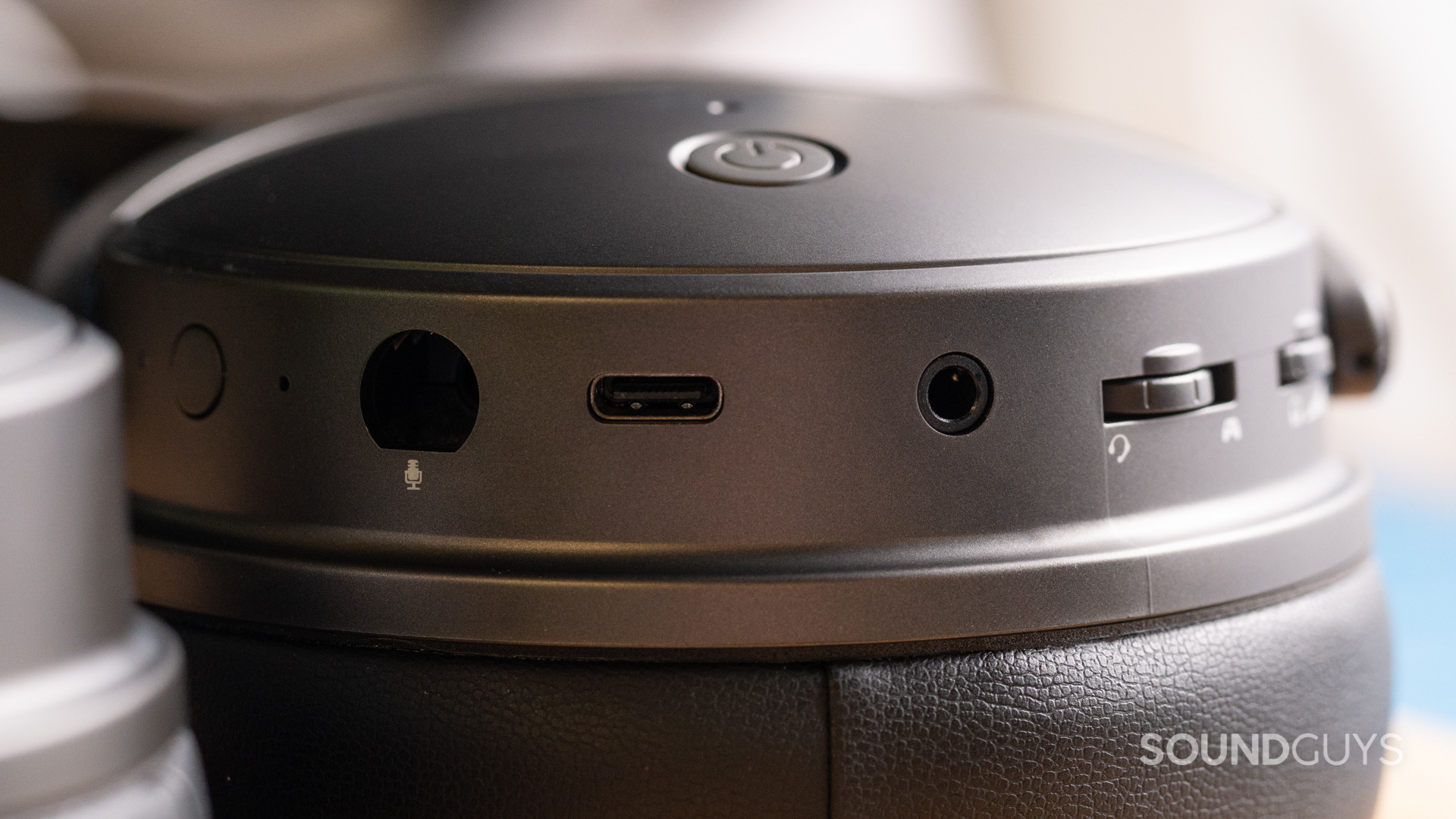
The Audeze Maxwell can be connected to just about anything with a 3.5mm port or USB-C for wired connections.
You can connect over Bluetooth for older sources via the LDAC, SBC, and AAC codecs. Though audiophiles may enjoy LDAC for its higher transfer rates, the other codecs aren’t as disappointing as they used to be. Bluetooth-heavy users will also appreciate the inclusion of Bluetooth multipoint support, which allows handoffs between devices as you bounce from source to source.
Given Audeze’s focus on high-end audio, it’s unsurprising that the company loaded the Maxwell with capable hardware. For example, the internal DAC can handle audio decoding from your source, meaning the Maxwell will not need external equipment for high-bitrate compatibility. For low-latency wireless, you can use the 2.4GHz RF USB dongle (Bluetooth is heavily source-dependent, so we can’t speak to your specific setup) to eliminate this worry. However, you’ll also be able to use an LE audio connection if your device supports it — giving you another low-latency option should your source support Bluetooth 5.3.
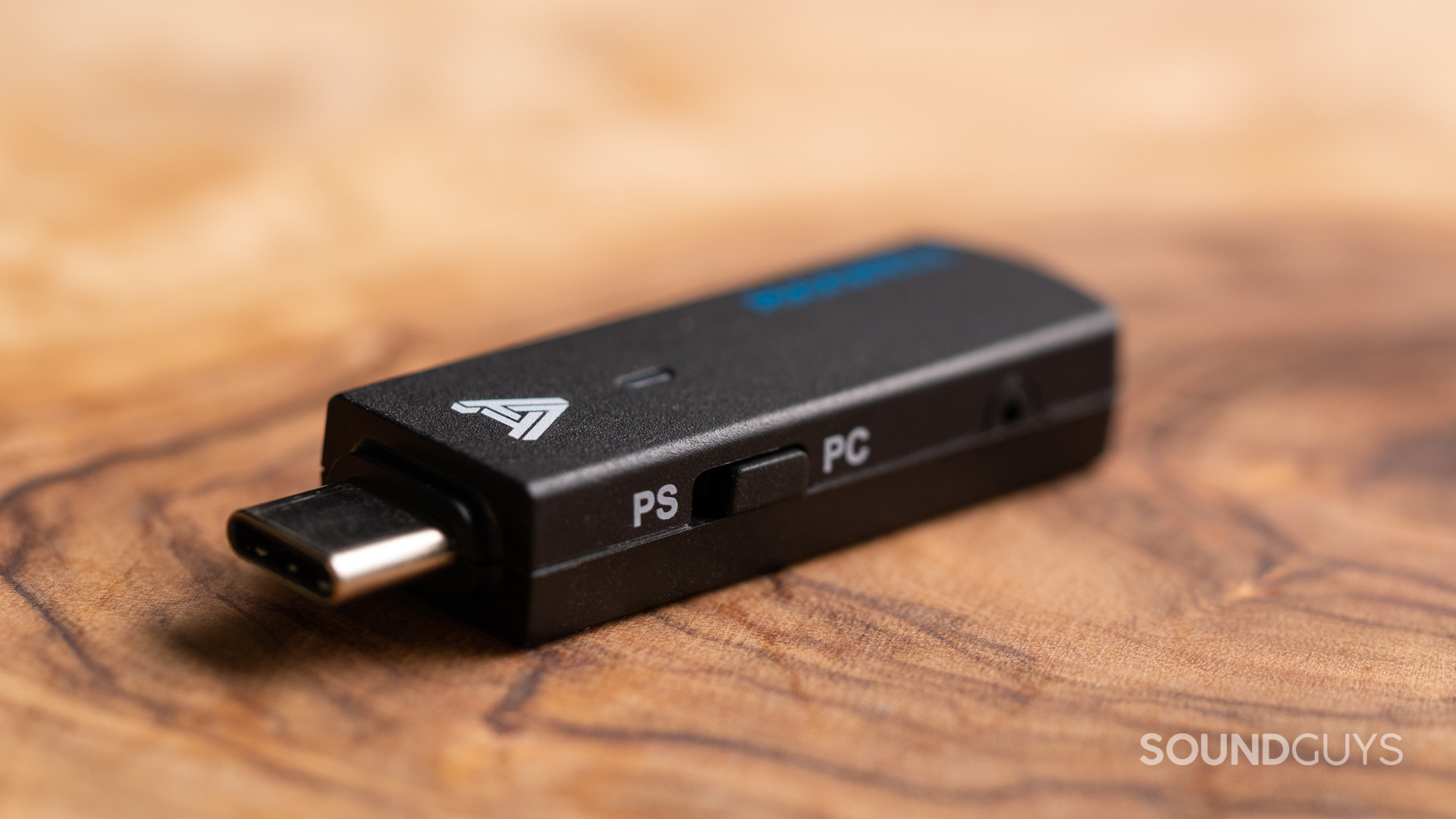
Christian Thomas / SoundGuys
The USB dongle enables a low-latency RF connection with anything capable of sending audio over USB-C.
Because the Maxwell has so many connection options, it’s unlikely you’ll be able to find a console or computer that it isn’t compatible with — but if you get a Playstation version, don’t expect all of the features to work on Xbox, and vice-versa. Though annoying, hardware licensing can get in the way of cross-compatible wireless options, which appears to have happened here. However, there’s no DRM with a 3.5mm connection, so that you can use that in a pinch.
To pair the Audeze Maxwell over Bluetooth, the process is very straightforward:
- Turn the Audeze Maxwell on by holding the power button for 3 seconds. This will put it into pairing mode.
- On your source device, scan for Bluetooth devices through the settings app
- Pair the Audeze Maxwell to the source device.
- (Optional) Open the Audeze HQ app for further options.
How long does the Audeze Maxwell’s battery last?
Though the Audeze Maxwell doesn’t post the best battery life we’ve ever tested, it lasts over 64 hours of continuous use in our testing. This may be short of the 80 hours advertised by Audeze, but that’s fine — it’s more than enough to last an entire week’s worth of gaming, and you can get 20-30 hours of playback time with a 20-minute charge (if you have a compatible 1.8 amp charger, anyways). So, if you exhaust the battery during a session, you should be able to take a quick break between rounds to get enough juice for another day. The extreme battery life headset is a relatively new phenomenon, but it’s very welcome. Anything that keeps headphones out of the landfill is a welcome feature.
How well does the Audeze Maxwell attenuate noise?
There’s no active noise cancelation, but the Audeze Maxwell can block noise reasonably well. The substantial ear cups and the relatively firm clamping force applied to your skull mean these headphones will seal reliably. By sufficiently isolating you from sounds above 200Hz, you should be able to easily ignore the noise around you.
The Audeze Maxwell’s isolation performance is good enough to block out everything but voice fundamentals, truck engines, and earthquakes — all things you’ll probably want to notice anyway. It does an excellent job of blocking noises that can interfere with speech intelligibility.
How does the Audeze Maxwell sound?
With large (90mm) planar magnetic drivers and a deep ear cup, the audio quality is impressive. However, you might have the itch to tinker with the out-of-the-box sound profile, as it deviates a little from our preference curve. For example, the default tuning strongly emphasizes the 3-6kHz range (atmospheric sounds, string attack) but a pronounced underemphasis on the sounds above 6kHz and the bass comparatively. You’re going to run into sound out of the box, but we can’t stress enough that this is just something that needs to be dealt with through the app. It is a straightforward fix. By connecting the headset over USB-C, for example, this was what we heard:
Like I said, though, the Audeze HQ app works magic — and is worth using if you will be using the Audeze Maxwell for any extended period. Firmware updates are another reason to keep that app on your computer. If, for some reason, you don’t like the sound of the Audeze Maxwell, you need to give Audeze HQ a shot because what you don’t like about the sound should be addressed with that utility. Here is how the sound changes when you update the preset with the Audeze EQ option in the software.
The Audeze EQ preset does a great job of providing a consumer-friendly sound. This preset follows the SoundGuys headphone preference curve well, with a little less high-frequency energy than we like. That slight under-emphasis in the highs might be noticeable to practiced ears. You shouldn’t notice any sounds that stand out over others in a grating way unless it was mixed to be that way. The disadvantage of this kind of sound is that it doesn’t satisfy every situational use — especially when you’re gaming instead of listening to music. That’s what the other EQ presets are for.
Several EQ presets are available to you through the Audeze HQ app, which are less extreme than those offered by other models on the market. Only the Footsteps EQ stands out as a situational performance booster among the presets below. The rest are intended to tweak the sound more closely to your tastes.
Bass boost EQ preset:
Thankfully, the boost in the bass isn’t ridiculous, but it still emphasizes the lows over the rest of your music.
Competition EQ preset:
This preset boosts highs to the point where they can be incredibly grating. It’s a poor choice for music, but it makes essential cues like footsteps and shots much clearer, so it can give you a theoretical edge in gaming.
Footsteps EQ preset:
By boosting the center frequencies of the fundamental tone of feet hitting solid ground and the higher-pitched sounds of the whole footstep, this preset gives you the best chance to hear people sneaking up on you. It may sound gimmicky, but it’s a time-honored tradition amongst gamers to make these EQ adjustments, so a preset is always handy.
Immersive EQ preset:
This is another minor EQ change; it’s much like the Bass Boost EQ but with better extension in the highs.
Treble boost EQ preset:
True to its name, this preset boosts treble like the Immersive EQ preset but tones down the sub-bass slightly. That’s about it. This preset is one of the better ones, but they’re all pretty good.
Gaming headsets have a challenge where what you might want in-game isn’t necessarily the tuning you’d like to use while listening to music. To combat this, most gaming apps will come with EQ presets; the same is true for the Audeze Maxwell. Different genres of games will put you in situations where hearing certain things is critical to your performance, for example, footsteps in deathmatches or low rumbles in some RPGs. Games like class-based shooters will see different needs depending on your role. The Audeze Maxwell handles this with a degree of specificity that I enjoy.
What about Dolby Atmos?
If you were looking at the Audeze Maxwell for its Dolby Atmos support, only the Xbox variant of the Audeze Maxwell has this processing enabled. Consequently, if you game exclusively on PC, Get the Xbox version of the Audeze Maxwell. Only get the PlayStation variant if you are using your headset with a PlayStation.
When you pick up the PlayStation version of the Audeze Maxwell, it supports Tempest 3D audio out of the box. So you’re not missing out; it’s just an issue of competing standards and licensing.
How good is the Audeze Maxwell’s microphone?
There are two microphones on the Audeze Maxwell: an internal one and a boom mic. We could not get the internal mic working with our test setup, but the boom mic worked perfectly. Take a listen below to hear our standardized samples.
Audeze Maxwell microphone demo (Ideal conditions):
Audeze Maxwell microphone demo (Office conditions):
Now that you’ve voted, I will say that you may be able to avoid that strange issue in the sibilants (-s, -sh sounds) by moving the mic further away from your mouth or moving the mic slightly off-axis.
Should you buy the Audeze Maxwell?
Despite a few caveats, the Audeze Maxwell is one of the best-performing gaming headsets on the market and should top the ranks for a few buyers — provided the budget (and neck strength) is there. Gaming headsets have their work cut out for them, and their audience is historically unkind to performance flaws. If you’re an older gamer with some cash to blow, you should be pleased with the Audeze Maxwell. The battery life is excellent, the sound is a cut above, and the features are about as future-proof as you’ll find. Under the hood, the Audeze Maxwell has everything necessary to satisfy the pickiest person out there.
Of course, a high-power product comes with a little more complication than your standard Plug’n’Play headset, so if you don’t care about advanced features or planar magnetic drivers, plenty of more affordable options exist. However, if you’re looking for something more future-proof: the Audeze Maxwell is it. Just be sure you get the correct variant for your uses, as you can get the wrong product if you’re hoping to use your console’s spatial audio features.
What should you get instead of the Audeze Maxwell?
If the fancy bells and whistles aren’t your speed or you want “something that works,” we usually steer people toward wired headsets because there are several excellent options on the market for PC gaming. For example, the HyperX Cloud Alpha might be ancient by comparison, but it’s rock-solid where it counts for under $100.

Harley Maranan / SoundGuys
The Audeze Maxwell’s boom mic is very competent but can sometimes be tough to troubleshoot positioning.
Of course, the Audeze Maxwell’s audio quality is not easily replicated by other gaming headsets, and the alternatives at its level are all made by Audeze. For example, the LCD-GX is a boom-mic-enabled version of the LCD-5 audiophile headphones, and the discontinued Penrose is another set of closed-back planar magnetic headphones with 3D audio support.
As far as direct competitors to the Audeze Maxwell go, there’s not a lot out there without some significant tradeoff or another, and anyone looking at the sub-$300 category for gaming headsets probably should either wait for something else to come along or stick with the Audeze Maxwell.
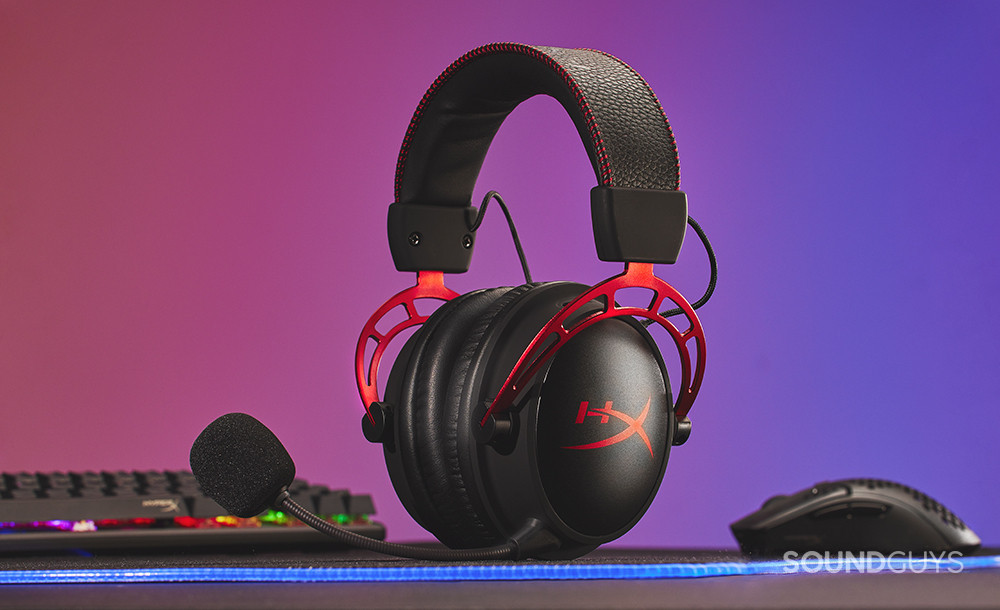
HyperX’s flagship Cloud Alpha Wireless headset is a battery-life beast.
If you can’t deal with weighty things on your head, you may want to accept the tradeoffs inherent in picking a smaller or lighter gaming headset. To that end, consider using the 390g Logitech G PRO X 2 LIGHTSPEED ($249 at Amazon) or the 327g HyperX Cloud Alpha Wireless ($151 at Amazon). Though neither headset offers the same kind of sound quality as the Maxwell, they both provide better battery life — quite ludicrously so when it comes to the HyperX — and less mass to strap to your noggin. While there will be a downgrade in your platform “hoppability,” not everyone needs to bounce from PS5 to Switch to PC daily.
Frequently asked questions about the Audeze Maxwell
The latency of the Audeze Maxwell is in line with expectations. If you believe your unit is misbehaving in this regard or there’s unreasonable latency with your unit, be sure to contact Audeze’s customer service for more help. Though it’s possible that the problem is not the headset, so be prepared for that.
Not always, but if you want wireless low-latency wireless gaming, it’s a good idea. If you’re listening to music, it’s not as big of a deal.



